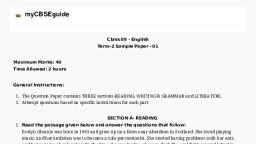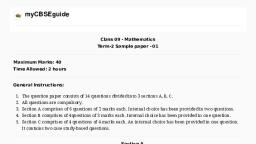Question 1 :
A cell having equal water concentration to its surrounding medium will neither gain nor lose water to the external medium.
Is it true?
Question 2 :
If cells of onion peel and RBC are separately kept in hypotonic solution what among the following will take place?
Question 3 :
When dry apricot are left for some time in pure water and later transferred to sugar solution, can we say that when placed in pure water, dry apricots swell up due to endosmosis. On being transferred to sugar solution, they shrink due to exosmosis?
Question 4 :
Osmosis is diffusion of water from the region of its higher concentration (pure water or dilute solution) to the region of its lower concentration (strong solution) through a semipermeable membrane. Is it true?
Question 5 :
Name the organelle which show analogy written as: Transporting channels of the cell.
Question 6 :
If you are provided with some vegetables to cook, you generally add salt into vegetables during cooking process. After adding salt, vegetables release water. What mechanism is responsible for this?
Question 7 :
Which kind of plastid is more common in flowers and fruits?
Question 8 :
Name the organelle which show analogy written as: Kitchen of the cell.
Question 9 :
A cell having higher water content or hypotonic cell sap will undergo exosmosis and, therefore, lose water. It may undergo plasmolysis. Is it true?
Question 11 :
If the organisation of a cell is destroyed due to some physical or chemical influence, what will happen?
Question 12 :
Which kind of plastid is more common in leaves of the plant?
Question 13 :
Endocytosis is swallowing up of food and other substances (bacteria, viruses) from external medium by the plasma membrane. This is possible only when plasma membrane is in direct contact with external medium. It occurs only in animal cells. Is this true?
Question 14 :
Where do the lipids and proteins constituting the cell membrane get synthesized?
Question 15 :
Name the organelles in plant cell that contain their own genetic materials and ribosomes.
Question 16 :
Plasma membrane is called selectively permeable membrane because it allows the movement of only selected molecules across it and not all of them. Is it true?
Question 17 :
Carry out the following osmosis experiment:
Take four peeled potato halves and scoop each one out to make potato cups. One of these potato cups should be made from a boiled potato. Put each potato cup in a trough containing water. Now,
(a) Keep cup A empty
(b) Put one teaspoon sugar in cup B
(c) Put one teaspoon salt in cup C
(d) Put one teaspoon sugar in the boiled potato cup D.
Keep these for two hours. Then observe the four potato cups and Explain why water does not gather in the hollowed out portions of A and D?
Question 18 :
If the plasma membrane reptures or break down then the constant internal chemical composition of the cell will be lost and it will not be able to perform its basic functions. Is it true?
Question 19 :
Amoeba obtain its food by the process of phagocytosis. State true or false.
Question 21 :
We eat food composed of all the nutrients such as carbohydrates, proteins, fats, vitamins, minerals and water. After digestion, they are absorbed in the form of glucose, amino acids, fatty acids, glycerol, etc. What mechanisms are involved in the absorption of digested food and water?
Question 22 :
The diffusion of water or solvent through a semi-permeable membrane from a solution of lower concentration of solutes to a solution of higher concentration of solutes is called _______.
Question 23 :
Can you name the organelles we have studied that contain their own genetic material?
Question 24 :
As lysosomes are organelles which on bursting can kill cells possessing them, they are called suicide bags. Is it true?
Question 25 :
Name the organelle which show analogy written as: Packaging and dispatching unit of the cell.
Question 26 :
When golgi apparatus is removed from the cell, formation of lysosomes, secretory vesiscles will stop. Is it true?
Question 27 :
Lysosomes are called scavengers of the cell because they remove cell debris consisting of dead and worn out cell organelle by digesting the same. Is it true?
Question 28 :
Name the organelle which show analogy written as: Digestive bag of the cell.
Question 29 :
When a red blood cell is kept in concentrated salt solution, they shrink and give a shrivelled appearance (crenation).
Is it true?
Question 32 :
Which cell organelle controls most of the activities of the cell?
Question 34 :
Cells are called as the structural and functional units of life because __________.
Question 36 :
Name the organelle which show analogy written as: Power house of the cell.
Question 38 :
If the organization of a cell is destroyed due to some physical and chemical influence, it will not be able to maintain homeostasis and thus will not be able to perform basic functions ( such as respiration, obtaining nutrition ,etc. )and such a cell will ultimately die. Is it true?
Question 41 :
As lysosomes are organelles which on bursting can kill cells possessing them, they are called suicide bags. Is it true?
Question 42 :
A cell having low water concentration or hypertonic cell sap will undergo endosmosis and absorb water from outside. It would become turgid. Is it true?
Question 43 :
Do you agree that a cell is the building unit of an organism?
Question 44 :
If there was no golgi apparatus, there would not be any lysosome for intracellular digestion and cleansing, not complexing of molecules, no exocytosis and no formation of new plasma membrane. Is it true?
Question 46 :
Which type of cell division is required for growth and repair of body?
Question 47 :
Plasma membrane is called selectively permeable membrane because it allows the movement of only selected molecules across it. State true or false
Question 50 :
Name the organelle which show analogy written as: Control room of the cell.
























